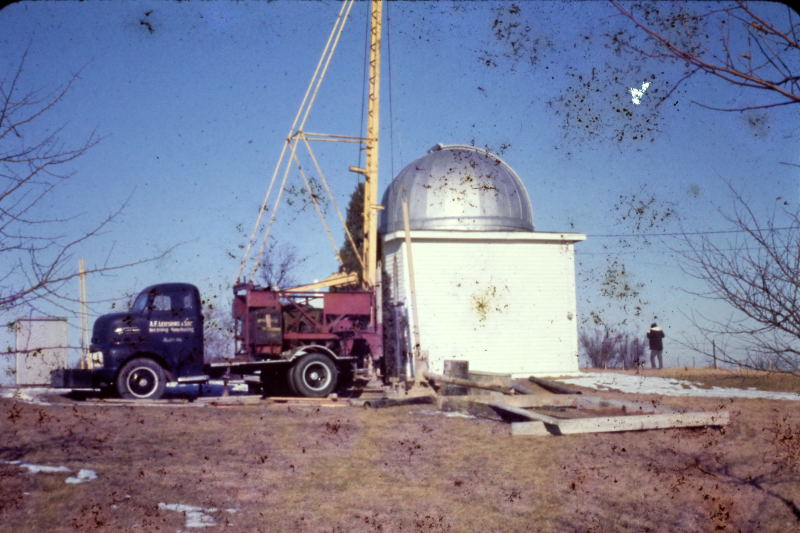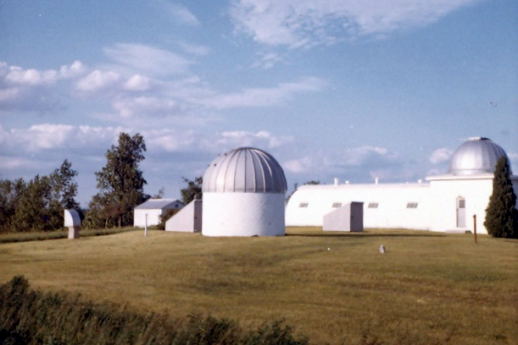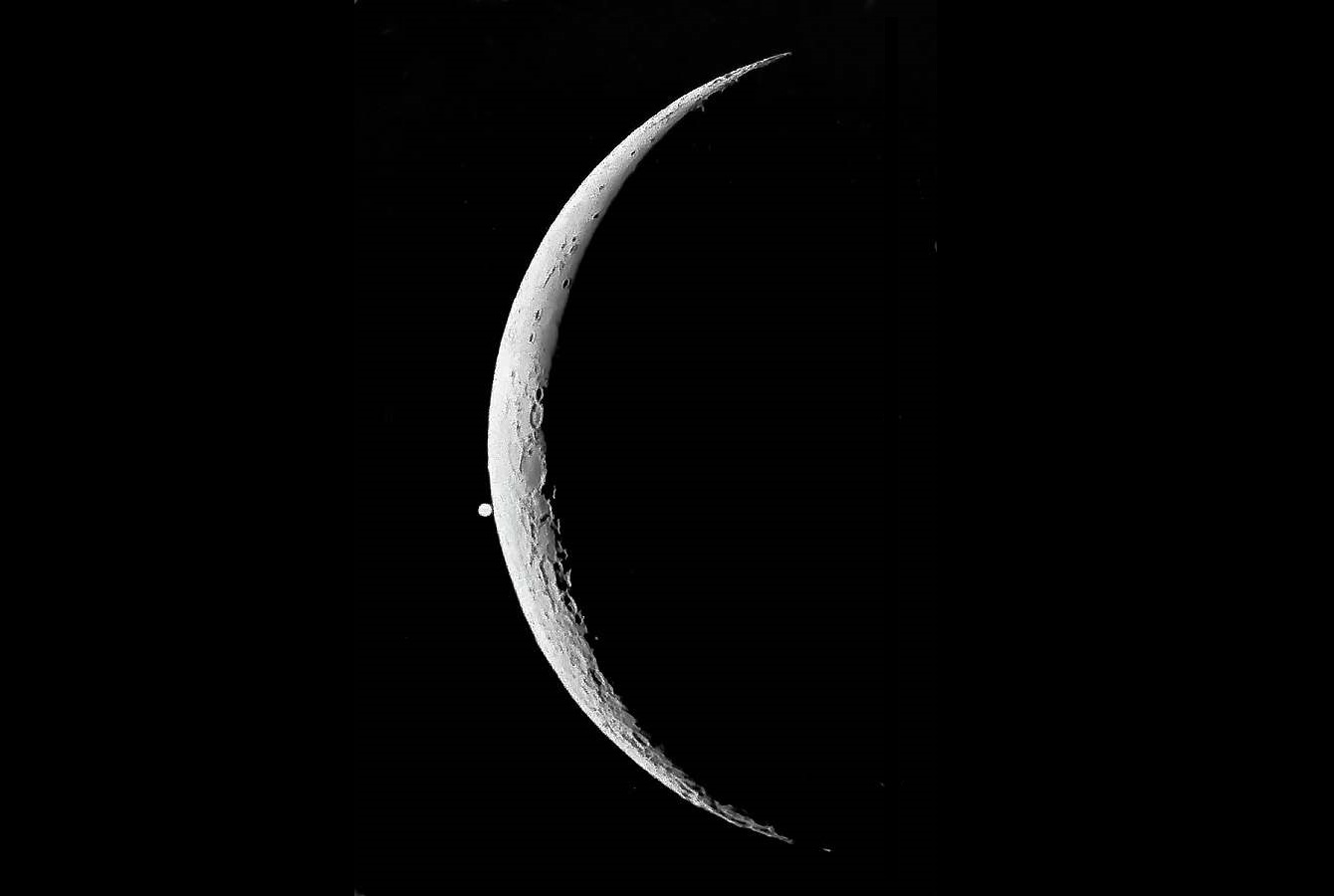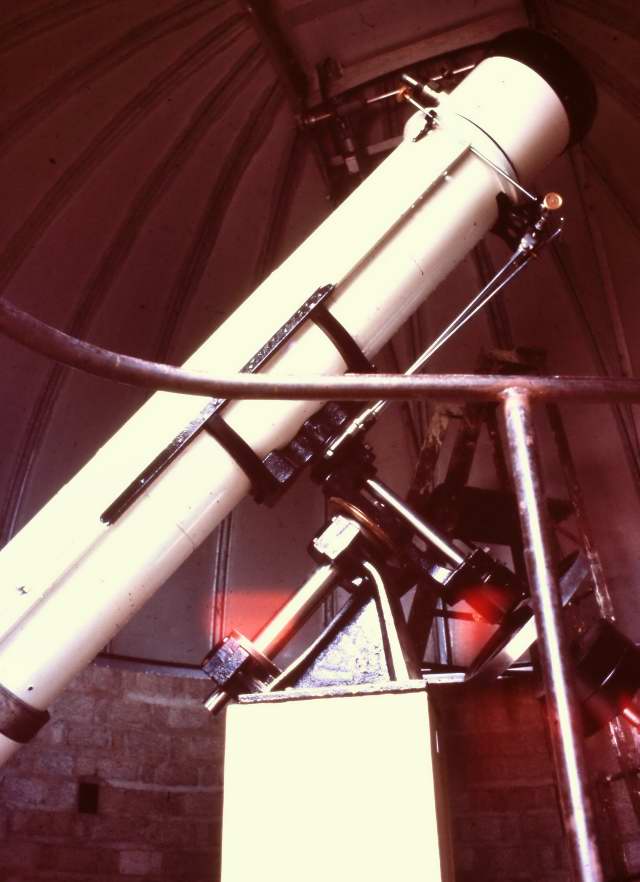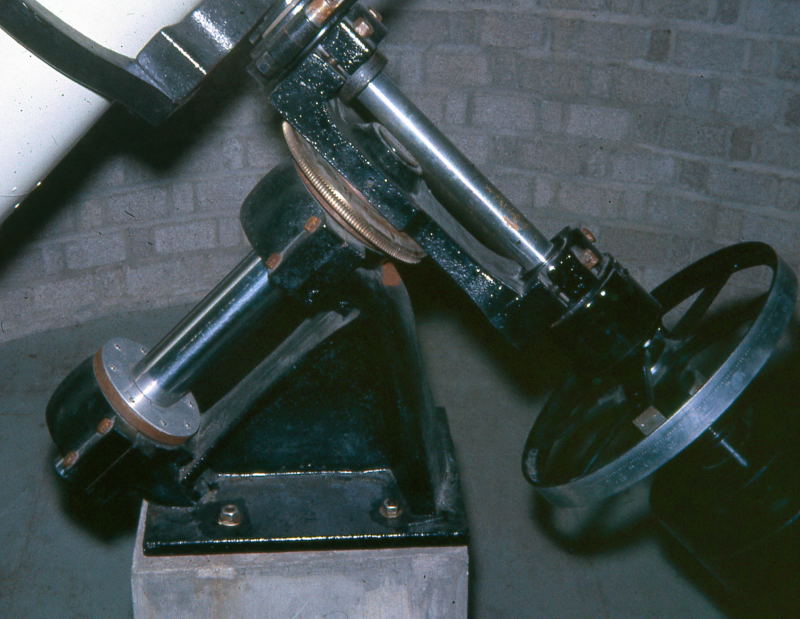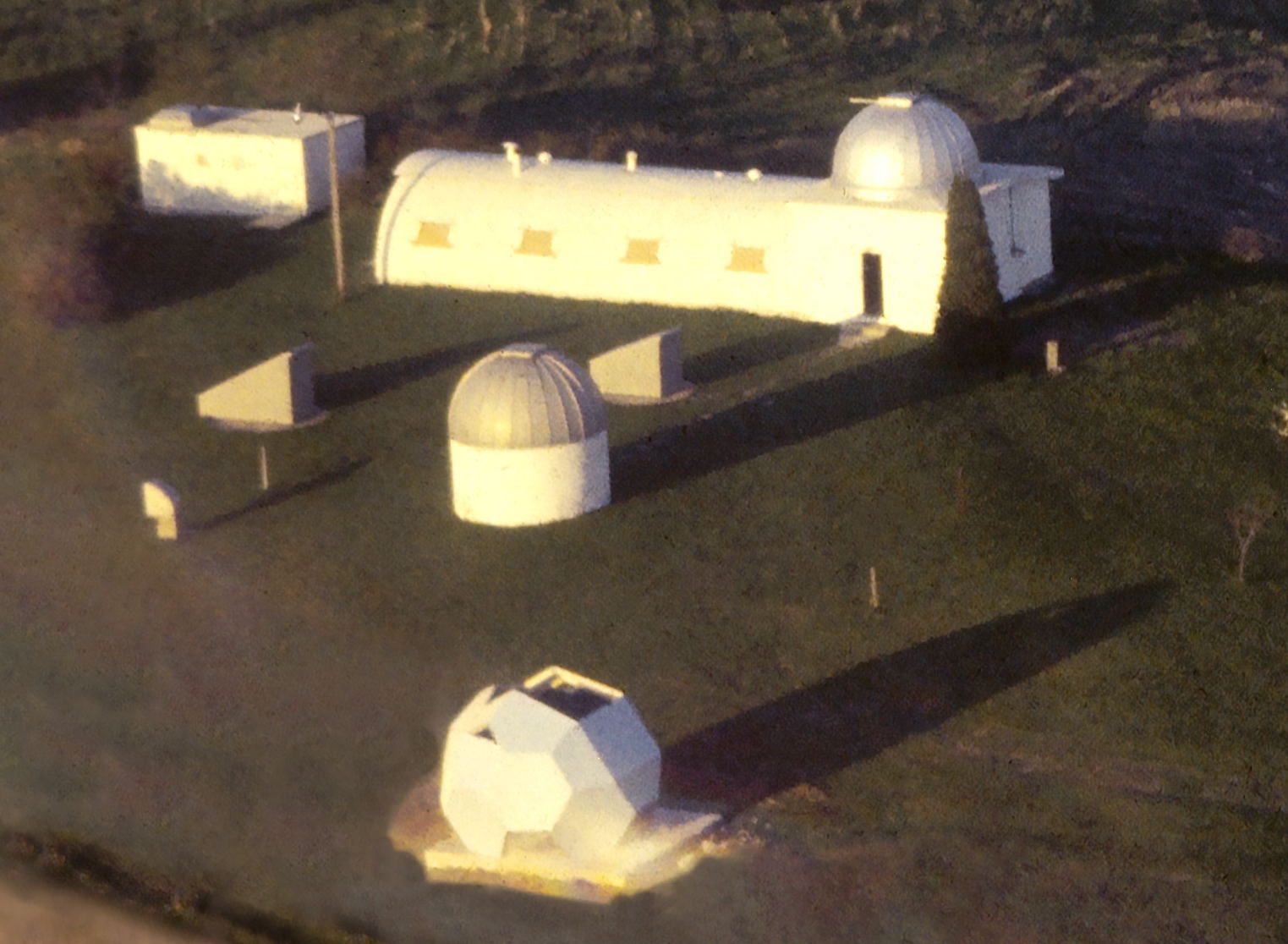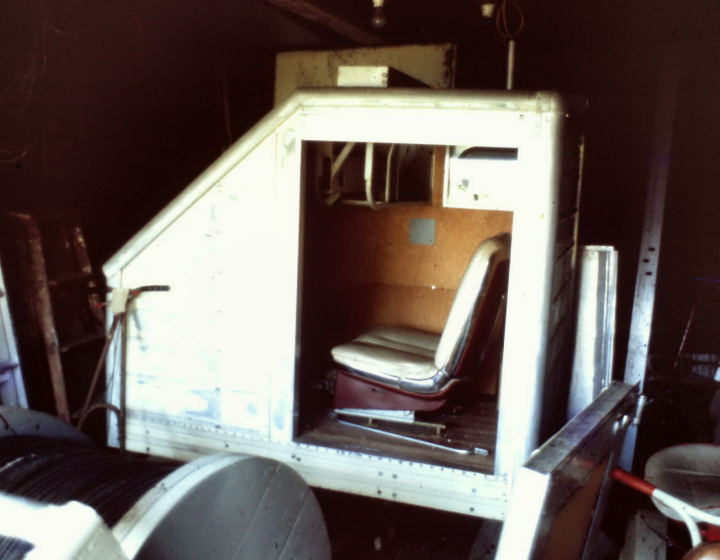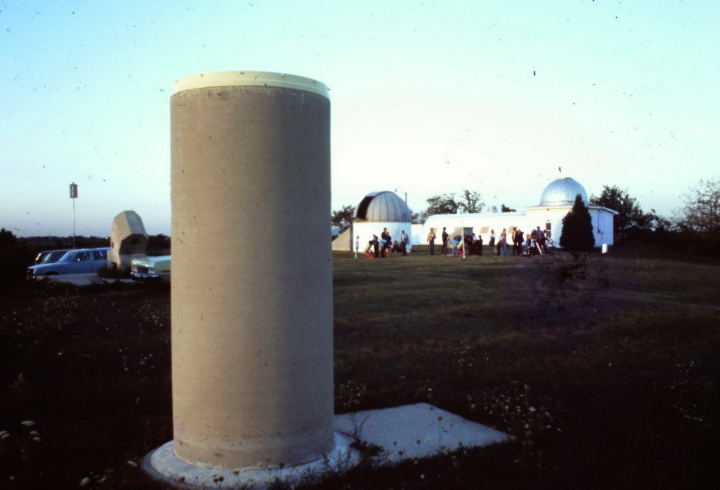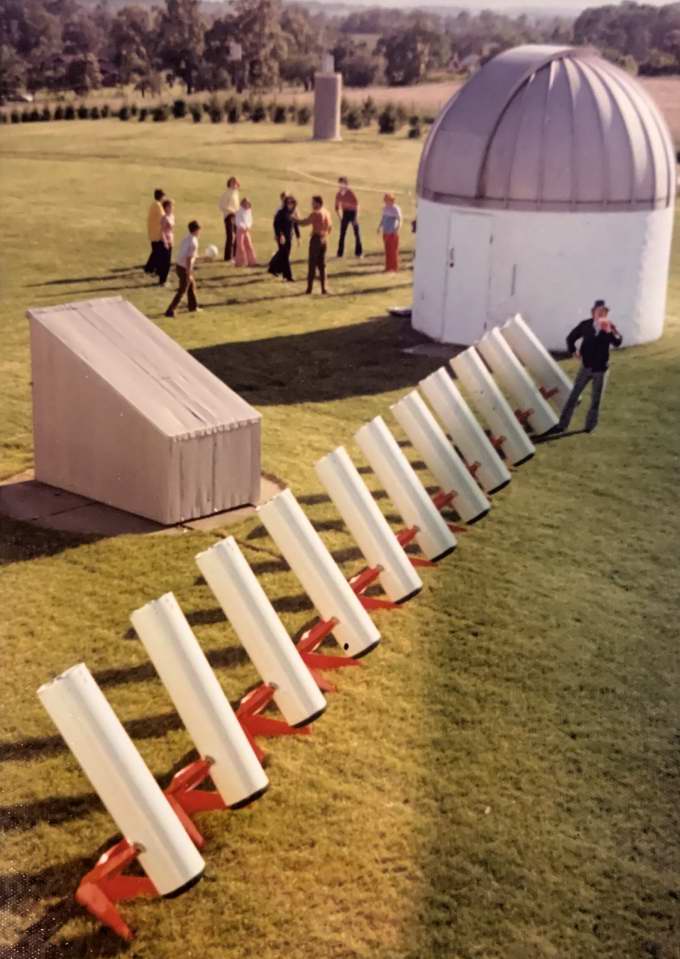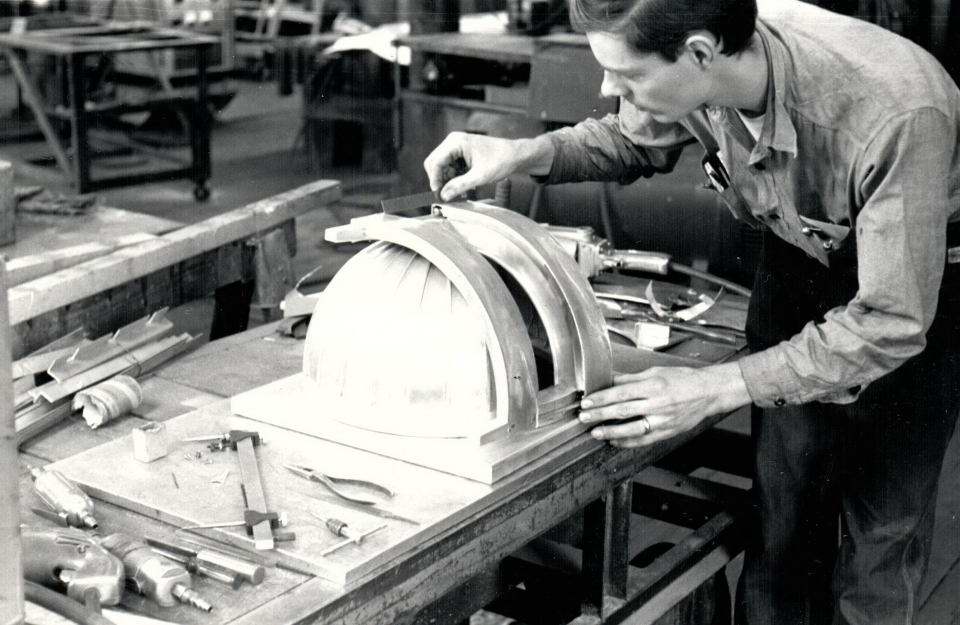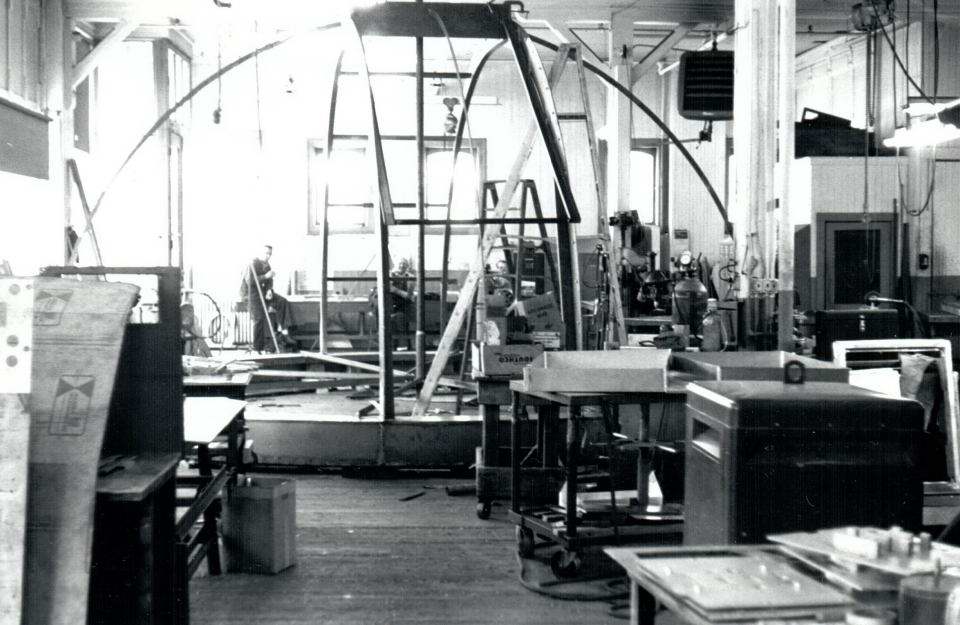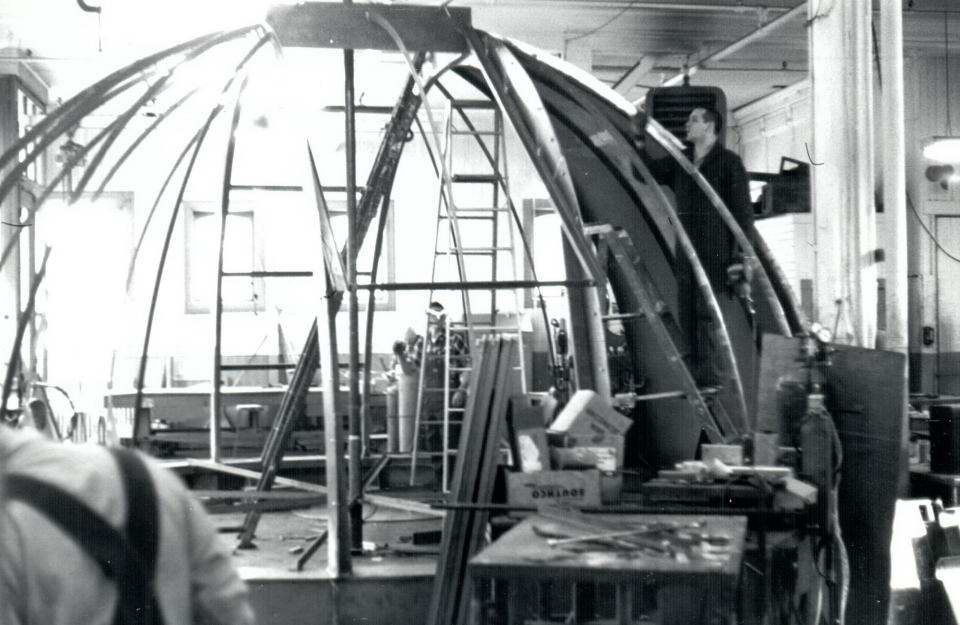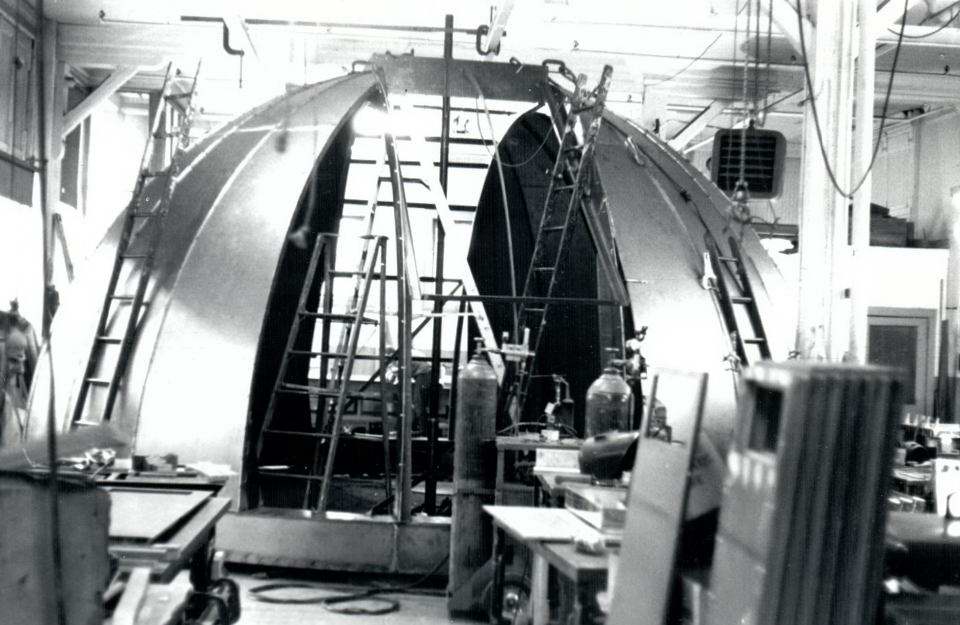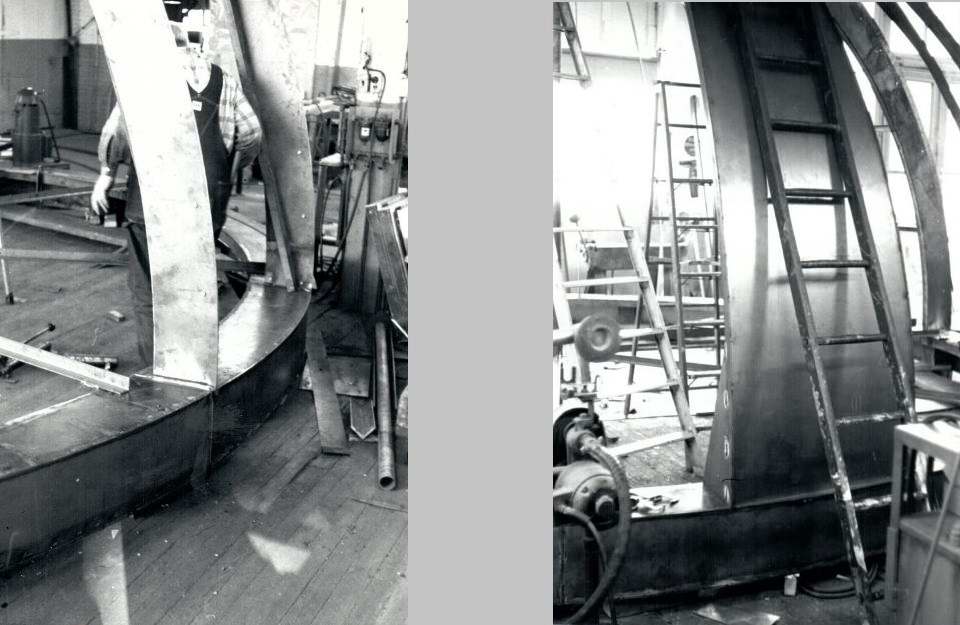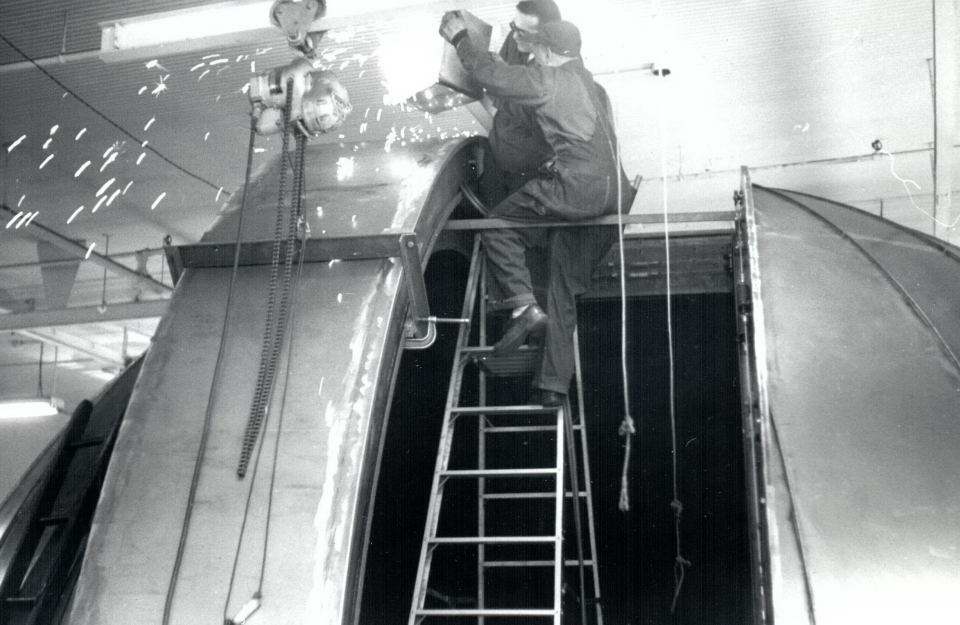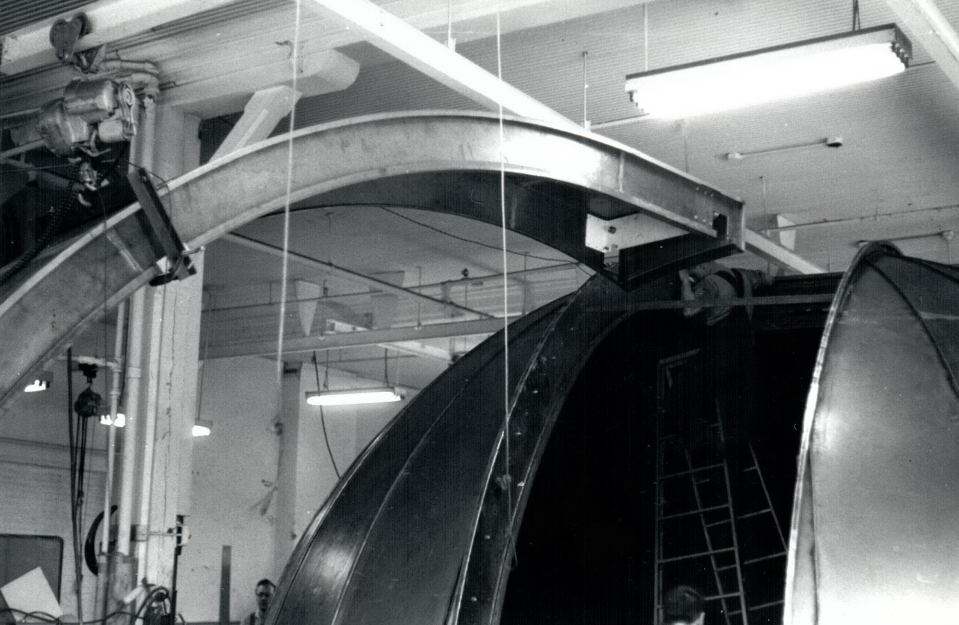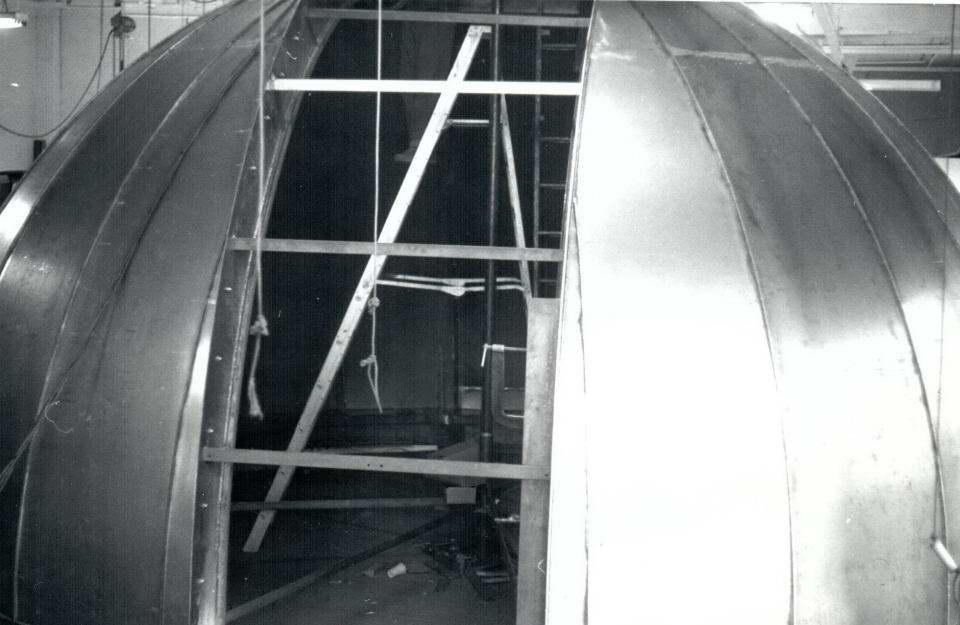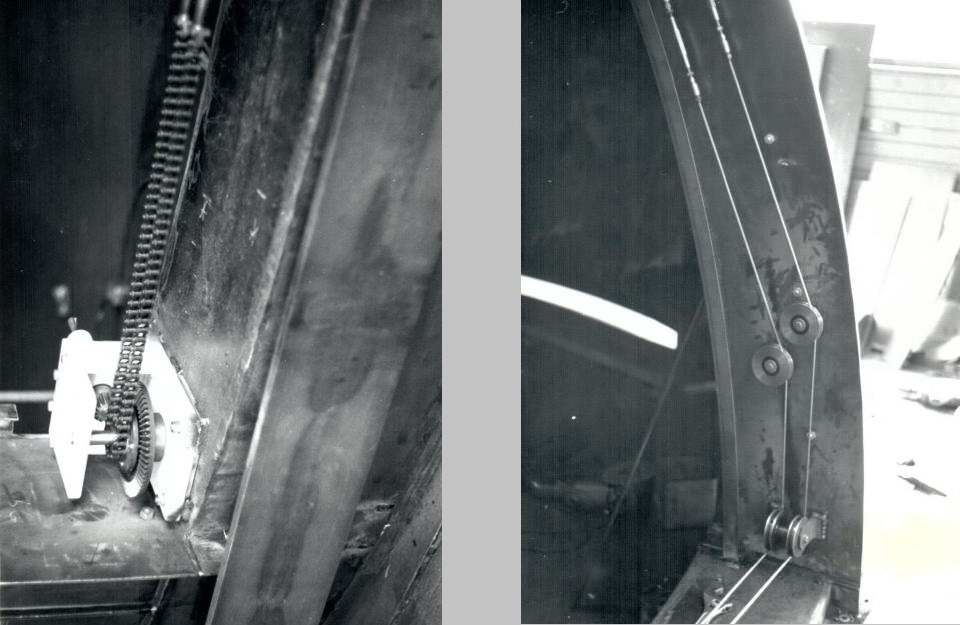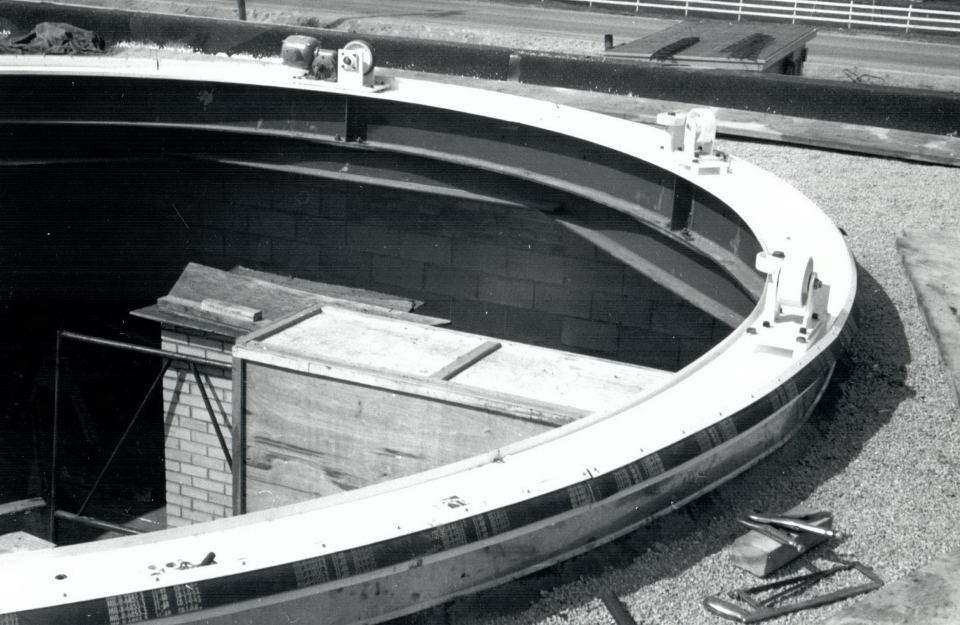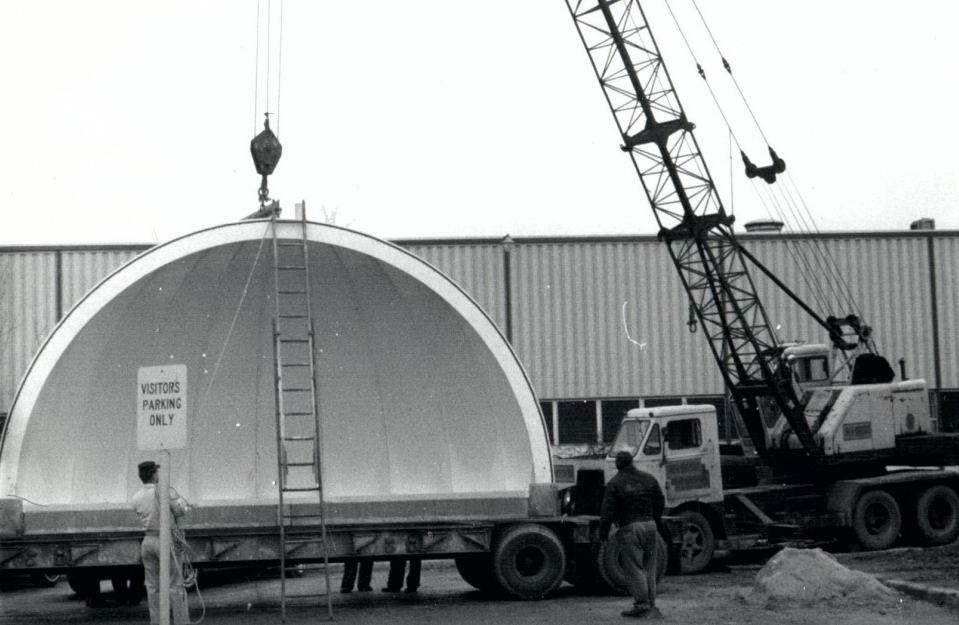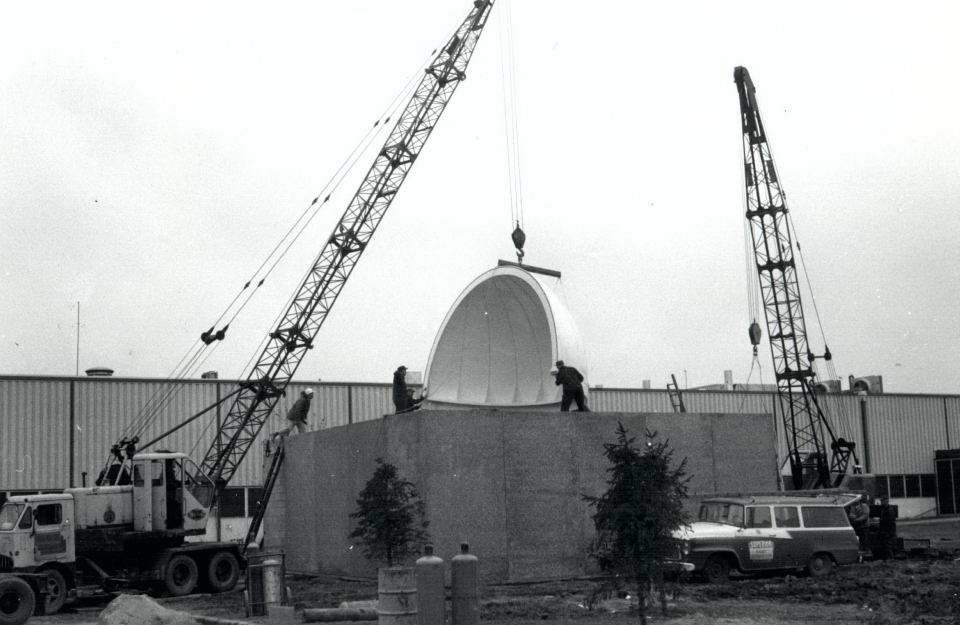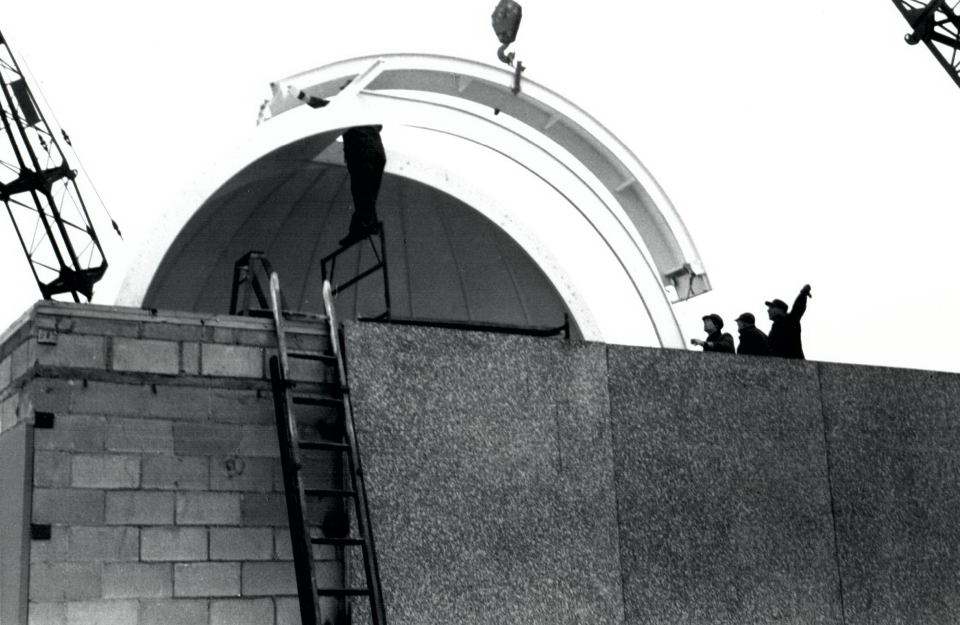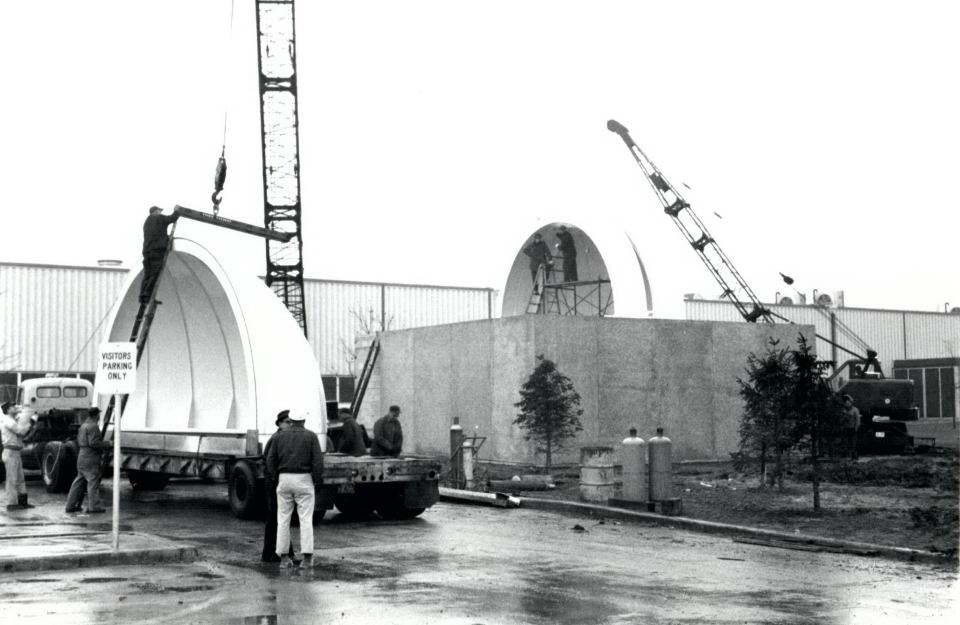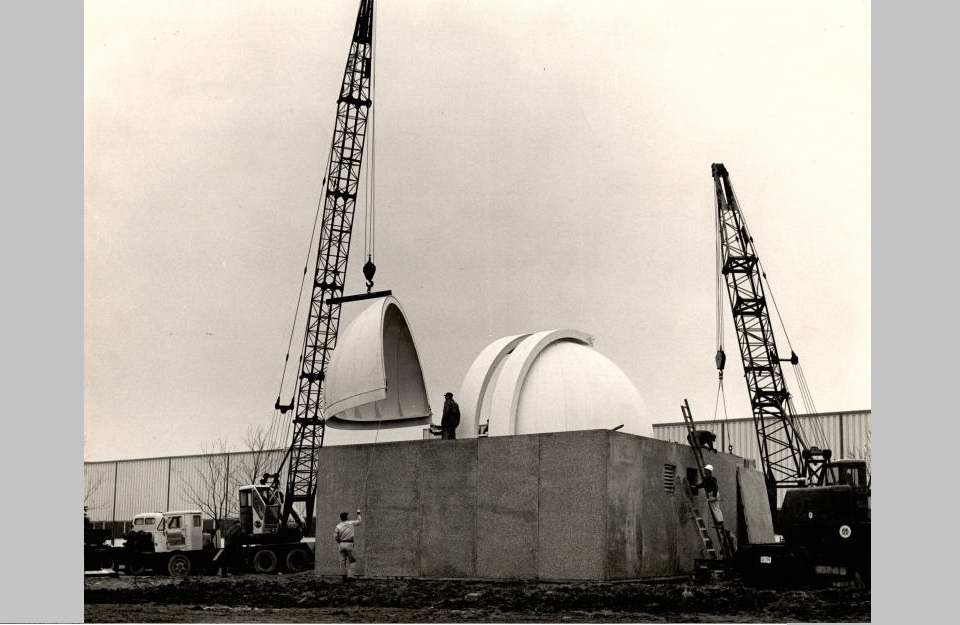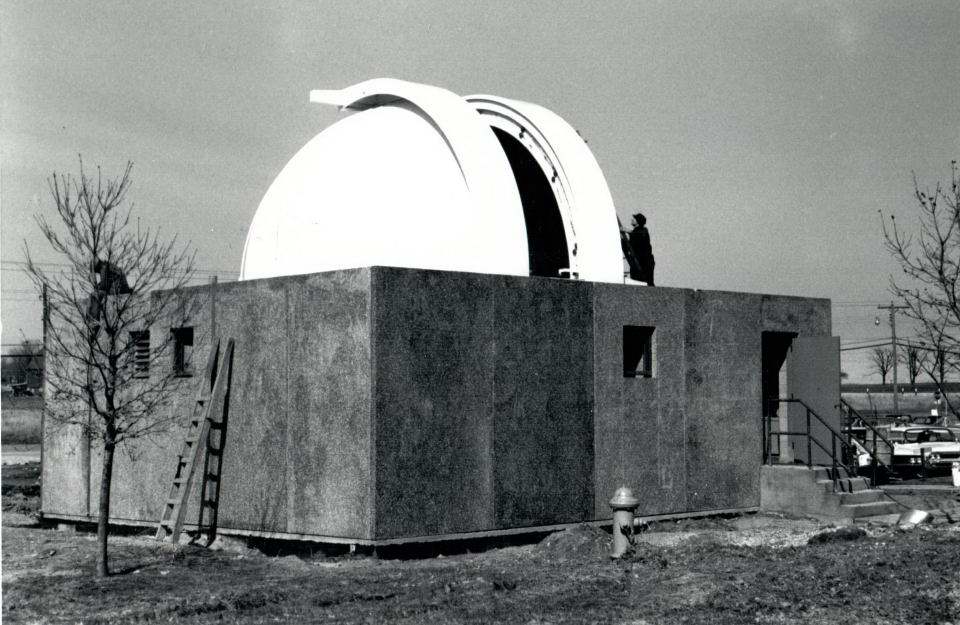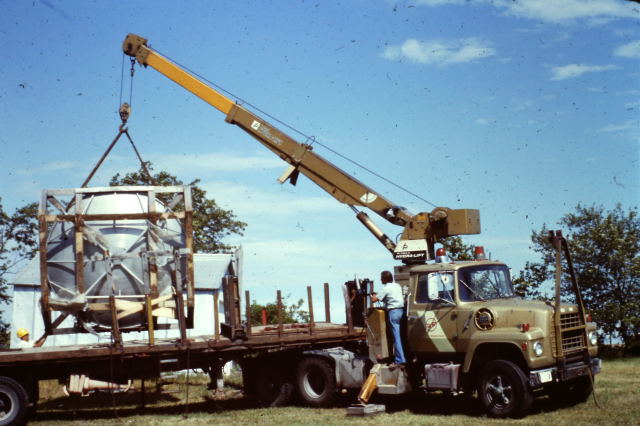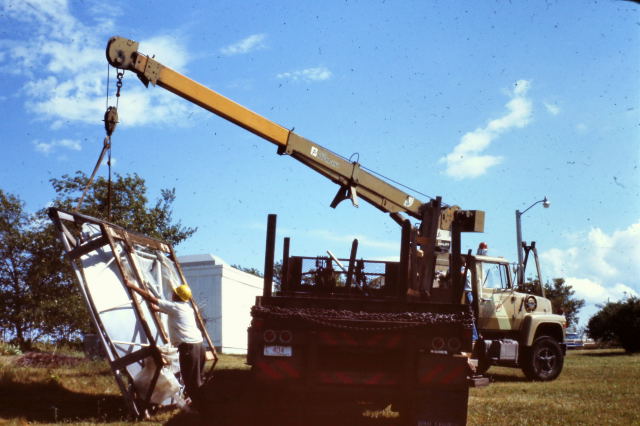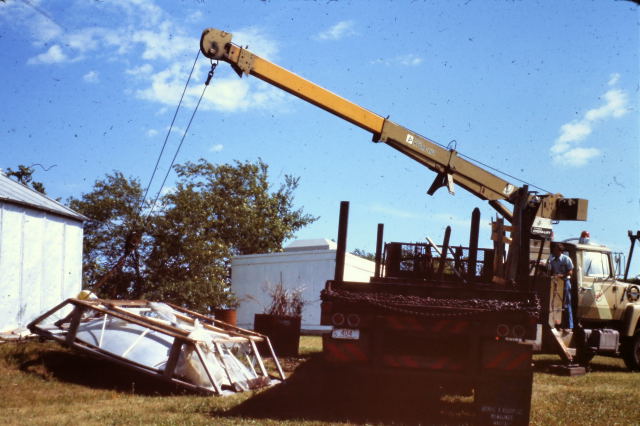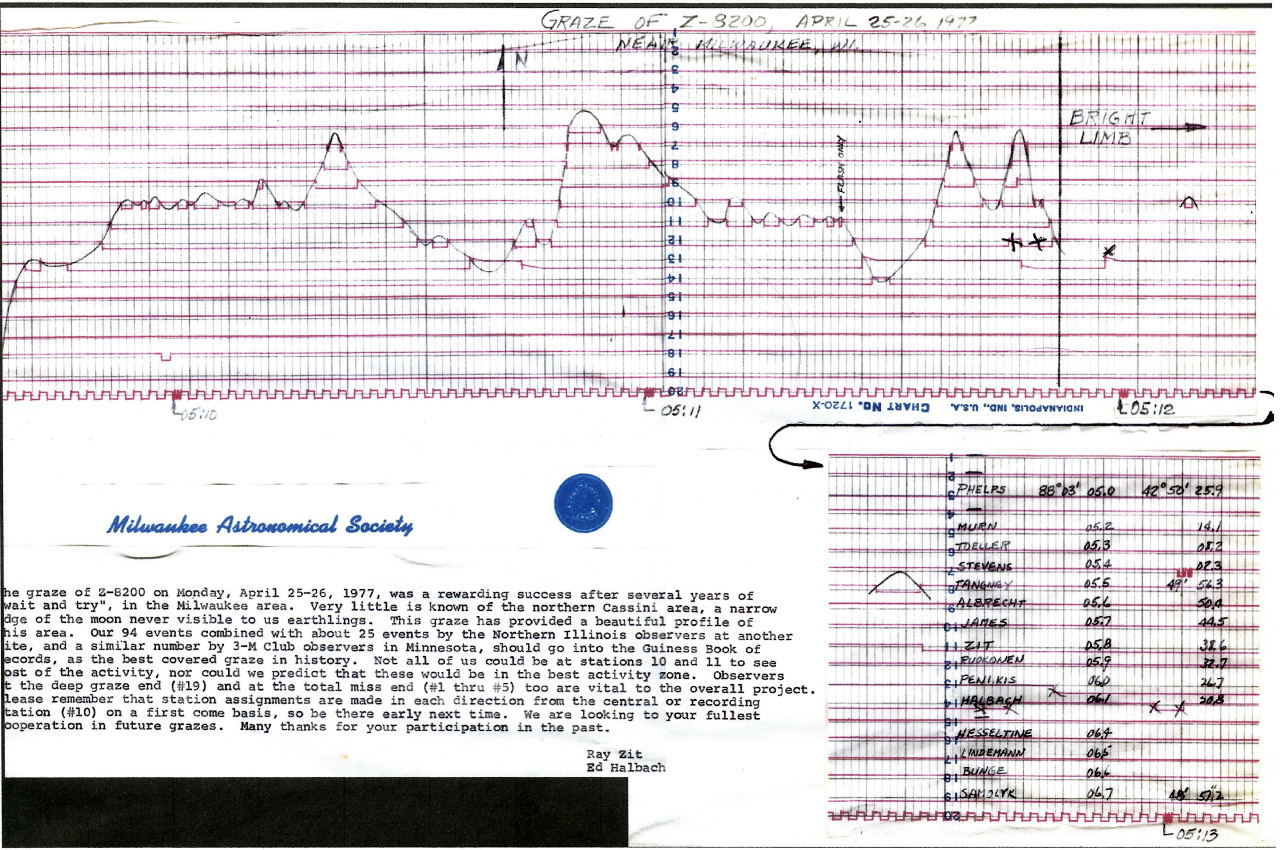History of the Milwaukee Astronomical Society
1964-1977 - Restrooms, Grazes, Portascopes, Halbach Retires
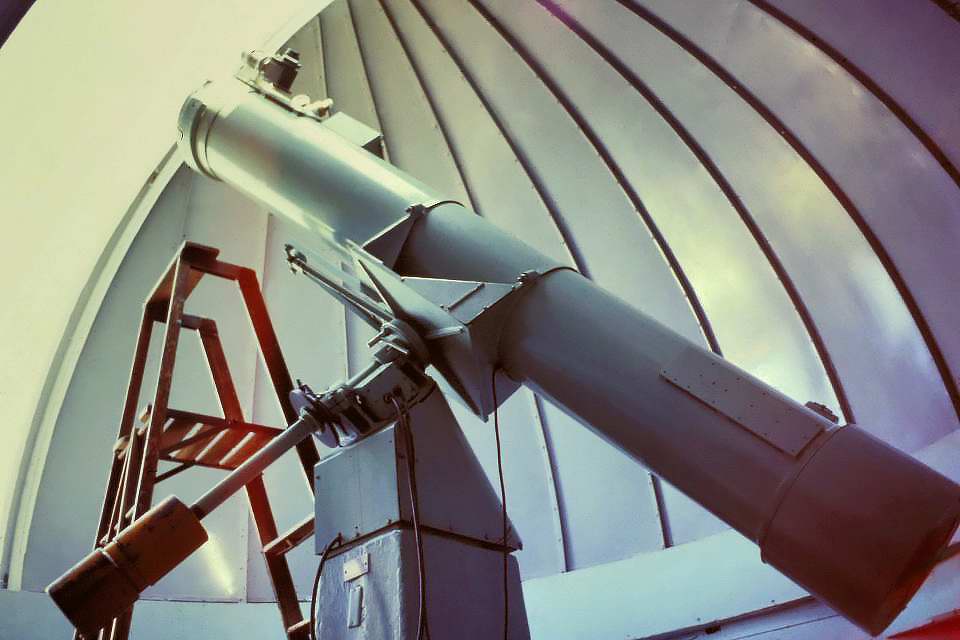 The Luverne Armfield Telescope (aka A-Scope) as it looked at the
time that the new mirror was installed.
The Luverne Armfield Telescope (aka A-Scope) as it looked at the
time that the new mirror was installed.
1964

The above aerial was taken in the spring of 1964 by Ed Halbach. It is significant for its timing.
Click here or on the image to get a full sized view.
In the fullsize
image you can they marked the new property lines in what look like tire
tracks. Note how straight the lines. You can also see on the east side of
the quonset the fuel oil tank. You should notice that the bathrooms and dark room addition to the A-Dome is not there as construction will begin later
that year. Curiously, it's hard to make out behind the garage the outhouse which must be used until the new bathrooms are completed. However, a note
in the logbook by Bill Albrecht states that he removed a toilet and hot water tank from the A-Dome later that year that must have been in the room they called the dark room.
But as the well was only recently drilled, we don't know where they would have got the water. (There is no mention in the log books about the installation of these items.)
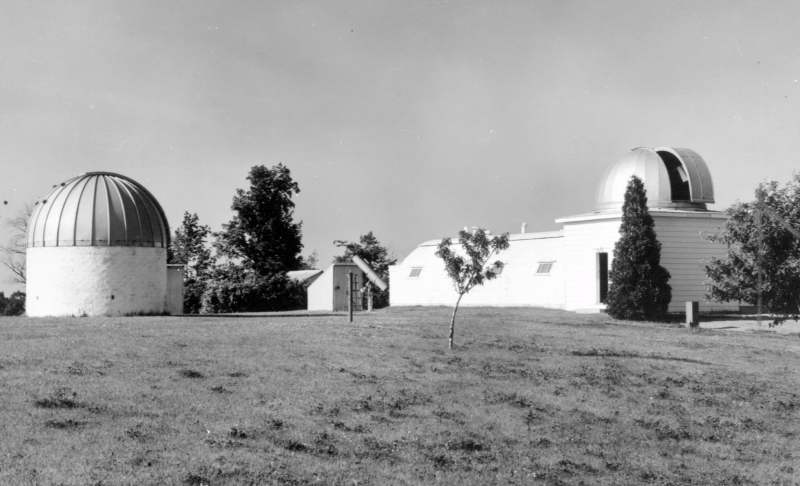 MAS Observatory in 1964. This was made into a large print which hung for in the Quonset for many years.
MAS Observatory in 1964. This was made into a large print which hung for in the Quonset for many years.
 Ed Halbach
is elected a Founder Member. 800 red pines are planted along the perimeter
of the observatory property. With the acquisition of additional land which
means we'll be staying put on the current property for the foreseeable
future, there is a plan to
install 2 bathrooms and a darkroom by extending the Armfield Observatory to
the east. A well is dug (172 feet) and a septic tank is built. According to the Double Dome
of October, 1962, Halbach states about this installation, "This could be of considerable benefit to all."
At this time they are still relying on an outhouse.
Ed Halbach
is elected a Founder Member. 800 red pines are planted along the perimeter
of the observatory property. With the acquisition of additional land which
means we'll be staying put on the current property for the foreseeable
future, there is a plan to
install 2 bathrooms and a darkroom by extending the Armfield Observatory to
the east. A well is dug (172 feet) and a septic tank is built. According to the Double Dome
of October, 1962, Halbach states about this installation, "This could be of considerable benefit to all."
At this time they are still relying on an outhouse.
Construction starts in July on the extension of the A-Dome building to the east for the bathrooms and darkroom. Much of the construction has been completed by winter.
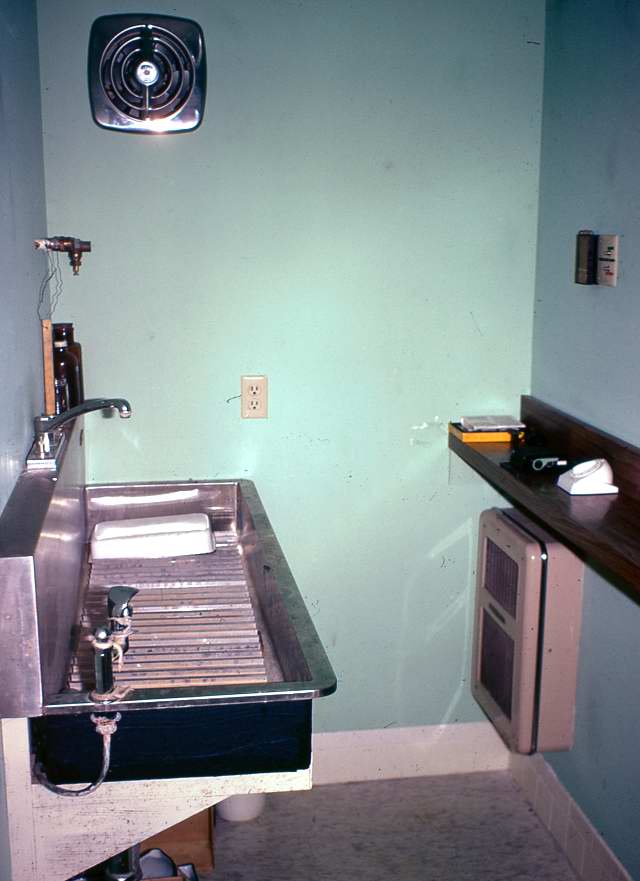 1965
1965
By April, construction is completed on the extension of the A-Dome building to the east for the bathrooms and darkroom. All three rooms have electric heat to keep the pipes from freezing during the winter. The cost for the project is $4,128.00.
There was a lot of maintenance on the observatory to get it top shape for the Astronomical League convention in July.
MAS becomes a leader in the new field of lunar grazing occultations. Halbach builds a trailer to hold 2 miles of cable for the timings. The Esterline Angus Instrument Company donates a 20 pen recorder for the project.
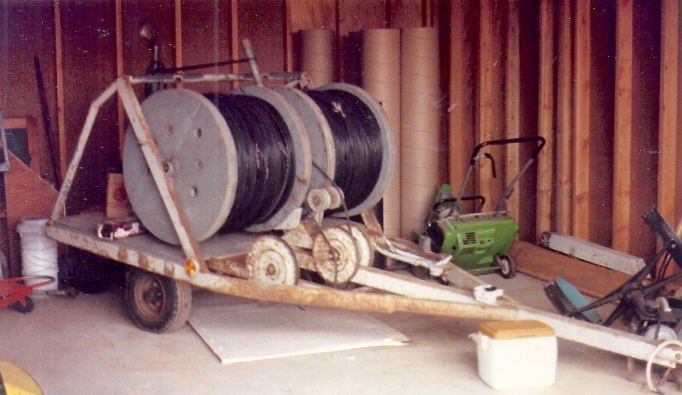 Graze Cable Trailer.
Graze Cable Trailer.
The 12.5" Buckstaff Telescope was rebuilt.
A couple of things to note. The B-Scope at this time does not have a clock drive nor an RA circle. In fact the mount is fastened to the pillar level. The mount had a 45° tilt so would need to be raised on the south end to adjust to get it to the needed 43°.
The 1965 joint AL-ALPO convention was held at the Hotel Schroeder in Milwaukee, Wisconsin, on July 2-5. The event was hosted by the Milwaukee and Racine Astronomical Societies. Attendance reached 280. There were simultaneous open houses at the MAS observatory and Racine's Modine-Benstead Observatory on Friday, July 3rd, and then again on Monday, July 5th.
On Saturday evening, 230 attendees enjoyed dinner at the Williams Collee Camp near Yerkes Observatory. Yerkes Director, Dr. W. Hiltner, gave a talk followed by nighttime observing through the 24 inch reflector and the 40 inch refractor. During the observation at the 40 inch, a long-time League member, 73 year old Floyd Shirey of Dallas, walked out onto the outer balcony of the giant dome and apparently lost his balance. He fell over 40 feet to his death. As a result of this incident, Yerkes Observatory discontinued public observing through the great refractor.
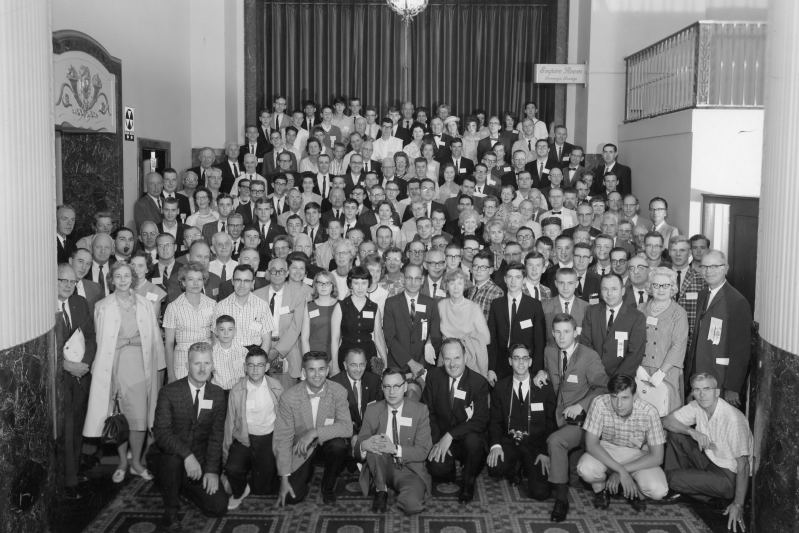
The group picture for the convention.
Click/tap here or on the photo for a larger view. The following MAS members can be seen
in the photograph: Ed Halbach, Bill and Anne Albrecht, John Pfannerstill, Ralph Buckstaff, Cora Zemlock, Virgil and Mary Tangney, Harvey Lindemann,
Herbert Cornell, Philip Glaser, Joseph Loepfe, Richard Fink, Gale Highsmith, Tom Osypowski, Walter Zinn, Bob James, and Roy Lee.
Click/tap here to see these names identified in the photo.
1966
Tom Pope leaves to work at New Mexico State University in planetary photography laboratory.
The Wisconsin Electric Company installed a yard lamp on the grounds of the observatory. The light can be turned off when needed. They have a special key to turn off the light and it also opens the chain at the parking lot entrance. This key became known as the "yard key."
The much anticipated 33-year peak of the Leonid Meteor Shower was clouded out.
Tom Thurner requests that he be permitted to erect a 20" f/5 telescope on the MAS property. Work begins by the pouring of the base and then the all-concrete pier for the Thurner Telescope.
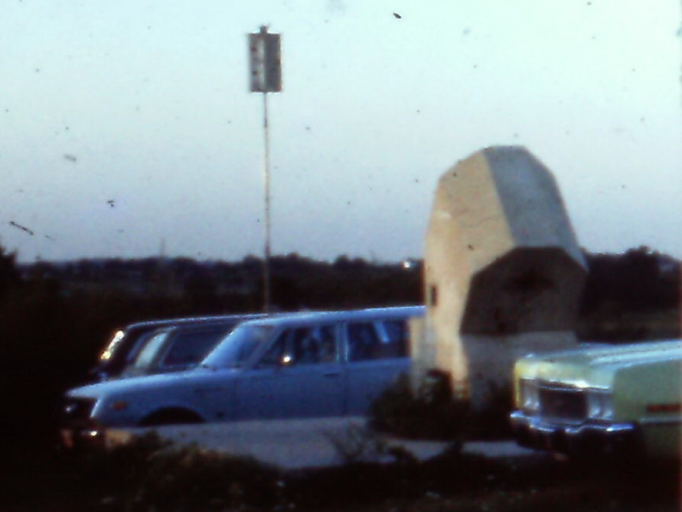 Taken during the 70's, this is the abandoned all-concrete base for the Thurner 20-inch telescope.
Taken during the 70's, this is the abandoned all-concrete base for the Thurner 20-inch telescope.
1967
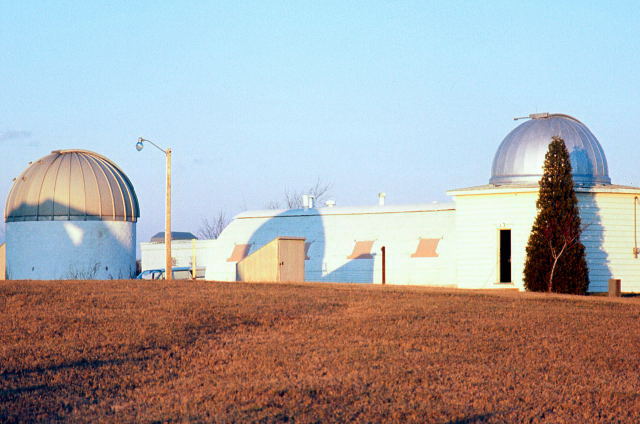 Observatory in 1967. Note the new lamp pole.
Observatory in 1967. Note the new lamp pole.
Construction of the Thurner observatory building which will be a roll away geodesic dome continues throughout the year.
1968
Construction of the Thurner 20" is abandoned. More evergreens planted along the west property line. JOMAS (Junior Observers of the MAS) begin working on a radio telescope.
The Wisconsin Michigan Pipeline Company purchased additional right of way along the west property line. They also paid $2,100 for the replacement of the trees they destroyed.
Aerial showing the MAS Observatory in 1968. The structure at the bottom is the observatory for the 20" Thurner reflector. Click/tap here for another aerial view.
1969
The Saturday Member's Night is expanded to the entire year and an assigned keyholder will open up the observatory and any society member can use the equipment.
After a disappointing graze attempt by 6 observers because of inadequate equipment, Ed Halbach proposes the club build a number of "easily portable" 8-inch or larger reflectors for the grazes and general use, especially at the Open House nights. [From the Nov, 1969 Double Dome]
1970
Halbach along with a number of helpers designs and builds 10 portable photographic telescopes using 120mm 20X satellite scopes on loan to the society. The JOMAS (junior members) group start assembling a proposed radio telescope using a 10 foot aluminum dish given to the society.
Bob James constructs a mirror grinding machine to help make 12 10-inch f/5.6 mirrors for the "Portascope" telescopes for grazing occultation work. The meeting hall in the Quonset essentially becomes a factory for the portascopes over the next 3 years. Introduction of the Yard Key which opens the gate and shuts off the street lamp.
![By Milwaukeeastronomer [CC BY-SA 4.0 (https://creativecommons.org/licenses/by-sa/4.0)], from Wikimedia Commons MAS 10" f/5.6 Portascope](../images/archives/MAS_History/portascope.jpg) Photo from:
Wikimedia Commons
Photo from:
Wikimedia Commons
1971
A clock drive is installed on the B-Scope. Twelve MAS members observe total solar eclipse in eastern Canada; eighth eclipse expedition for Halbach. The first 10-inch graze telescope is shown at the January dinner meeting. High winds blow down the radio telescope, damaging it beyond repair.
1972
With frustration with the performance of the B-Scope (the clock drive is still not working), Bill Collins suggests that "The Klunk" (his assessment of that scope) be placed in one of the runoff sheds and a new and larger instrument be put in the B-Dome. He gets permission to place an ad in Sky & Telescope for a large mirror blank in any grinding phase. He receives 3 responses, but one of them is a standout: a 26" mirror blank that the owner claims to be one of two trial pourings by the Corning Glass Works in 1934 for the 200-inch Palomar Telescope mirror. The disc has been ground previously (but not aluminized) with a curve of f/2. Longtime MAS member Cora Zemlock donates money to buy the mirror and to have it shipped.
Work on a Comet Seeker progresses. The cab is basically completed and the pier is poured. But this is as far as the project will ever progress.
1973
Bill Albrecht begins the process of planning for the 26" telescope. He starts by looking for a new site for the large telescope and a future move for all equipment. Also, he starts work on design and drawings for the telescope.
1974
12 graze telescopes (aka Portascopes) are finished. Ed Halbach accepts an award from the Royal Astronomical Society of Canada for the Portascope design. Halbach starts MAS on the Eclipsing Binary Program to determine periodicity of EB stars. The B-Scope is renovated.
There is great excitement over the arrival of Comet Kohoutek (advertised as the Comet of the Century) which will be at maximum during the winter. The MAS decides to hold a special open house at Whitnall Park to accommodate the expected crowds and 25 members came to help. 1150 people come out in the cold and are largely disappointed as it wasn't even the comet of the year.Membership dues are increased to $20.
Two views of the observatory grounds from the North looking South.
1975
The societies purposes were restated; twofold: education and research.
The B-Scope gets a right ascension circle and the mount is finally adjusted for precise polar alignment.
The A Dome is now power driven. Halbach notes that generally 17 telescopes are available for use at the observatory. MAS wins an award for the design of our Portascopes.
Plans for the 26" telescope are being revisited as it seems the time has come to move on the whole project. A formal request will be made for the AC Delco Dome by Bill Albrecht. Help in dismantling the dome may be received from Mr. Nagy of Spancrete Company.
The Story About the Delco Dome
While employed at Super Steel, Albrecht got to design an observatory dome for the AC Spark Plug division of General Motors (later known as Delco). AC Electronics was building guidance systems for the military and aerospace interests, which would include the Apollo missions to the moon. Basically it was a geodetic device. Super Steel then manufactured the dome in their warehouse at 4th and McKinley. Albrecht noted, "I sneakily designed their dome so that when they were finished using it I could take it down and bring it to the Milwaukee Astronomical Society." However, Albrecht had as cover the practical reality that by building it in three pieces, they could easily get it out of the warehouse and then transported to the site. His reasoning that they wouldn't be using the dome for an extended period because they really only needed it as a Geodetic device.So with the dome having a very limited lifetime use it would always be on the minds of the MAS that one day when they didn't need that facility they'd donate that dome to the club.
26" design plans are being reviewed to cut costs. The design of the mount was been changed to a fork and no machining because it can be made out of weldments. A scale model of the 26" scope with the new mount was made and shown at meetings and at the public open house nights.
In Novemeber, Albrecht reports the Delco Dome will not be available for at least 5 years. This was regarded by some as a major setback in the program.
2160 people attend the Open House nights that year.
1976
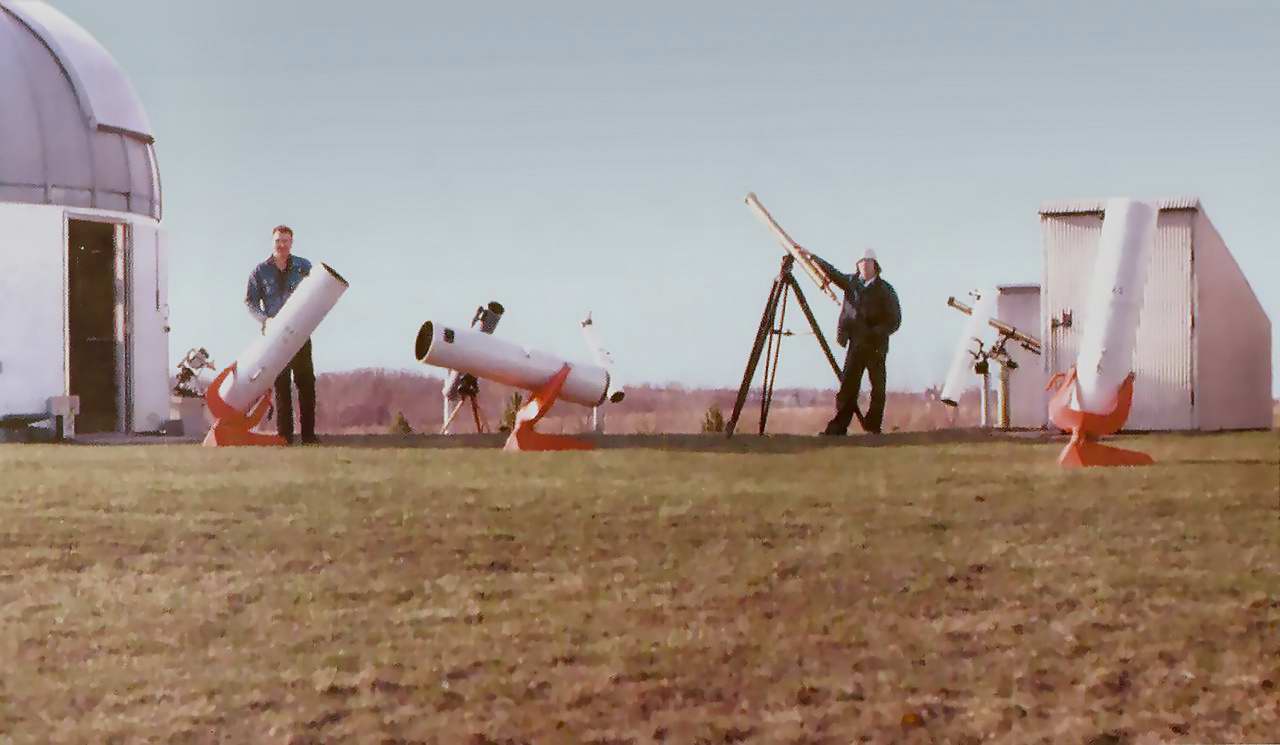 EB telescopes. Left: Gerry Samolky. Right: Gary Wedemeyer.
EB telescopes. Left: Gerry Samolky. Right: Gary Wedemeyer.
EB Program in full swing lead by Gerry Samolyk; MAS observers contribute 30% of world's total data for the program.
At the May membership meeting, Ed Halbach announces his retirement. He resigns as Observatory Director as he will be moving to Colorado the following year. Bob James takes over in May, but he annouces it's temporary and won't seek a full term. Raymond Zit assists and soon will take over the directorship.
Plans are drawn up to move the observatory to a site near Holy Hill from land to be donated by William and Anne Albrecht upon successful completion of donations for the telescope and observatory. They will investigate hiring an outside firm for professional fundraising help, but the flat-fee cost would be $4,500 to $6,500 with unknown variable cost. Consequently, they decide against, but may revisit this at some future date.
In July, a 10-foot parabolic dish located in Slinger is donated and Wisconsin Electric transports it to the observatory. The JOMAS (Junior Observers of the MAS) in the years previous had fashioned their own 5-6 foot dish out of aluminum, but was demolished by high winds. Unfortunately, the donated dish will never be used.
1,584 people attend the 6 open house nights.
1977
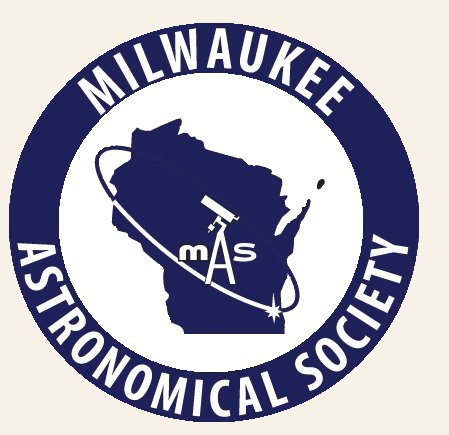 Harold Schenk of Sheboygan wins the emblem design contest. It remains our emblem and logo to this day!
Harold Schenk of Sheboygan wins the emblem design contest. It remains our emblem and logo to this day!
The old Armfield Scope (aka A-Scope) is completely rebuilt and rededicated as the Edward A. Halbach Telescope. Nine observers obtained record graze results; 108 data points at region of limb near Cassini. See the photo below:
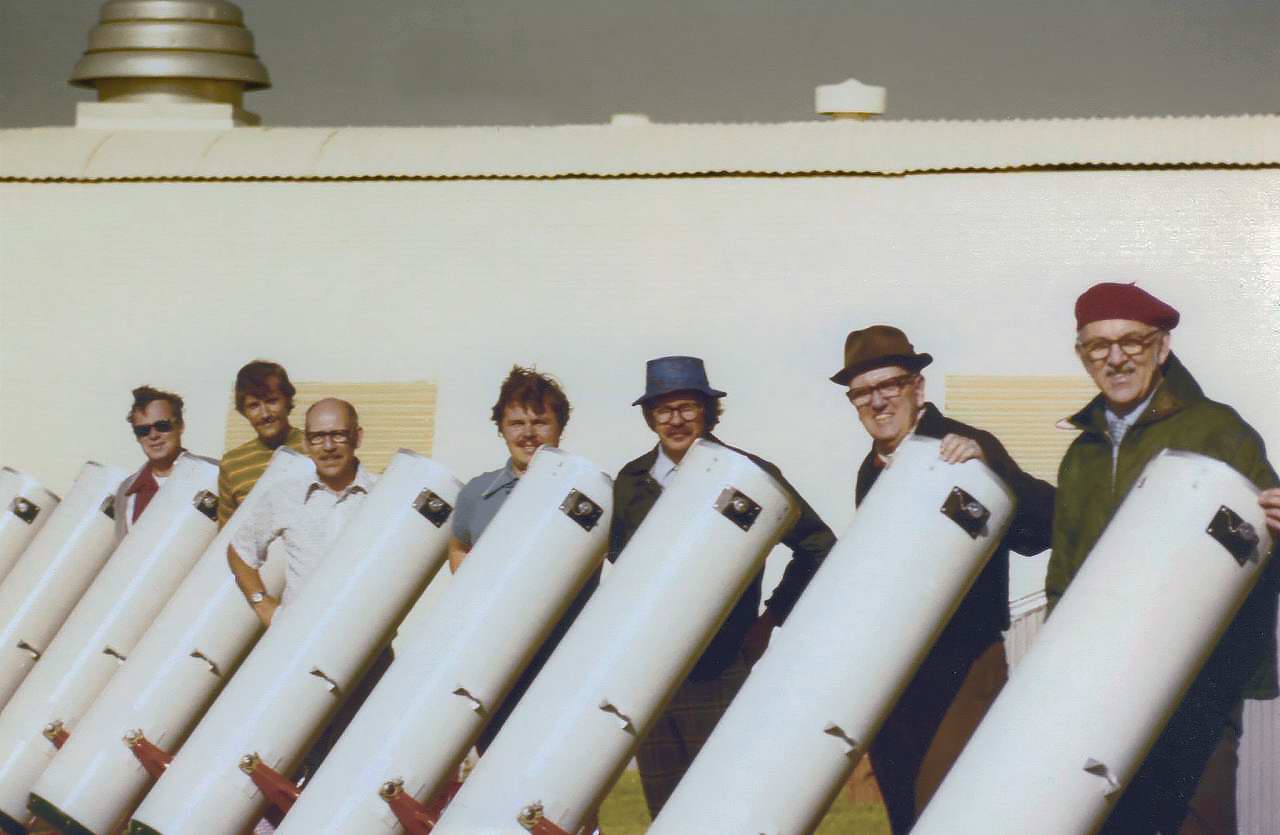
Portascopes. From left: Jim Toeller, Paul Murn, Virgil Tangney, Ken Krahn, Bill Collins, Bill Albrecht, and Ed Halbach.
A questionnaire on the 26" to the membership who attended a recent meeting resulted in these results. New site: 17, Present site with a new dome, 20,
Rolloff Shed/Roof: 8. 3 wanted the least expensive option. They decide they should mail the questionaire to the entire membership. Those results:
105 responses.
For larger scope: 99 yes, 6 no
For new site: 46
For present site: 36
For rolloff shelter on present site: 7
For financial aid: 79 yes, 17 no
Albrecht indicated that $105,000 is the amount that will be needed for the new site. This figure includes cash from the sale
of the present property. This revised figure is a "bare bones" estimate and would not provide for fringe items such as a well,
septic tank, work shop, etc. Ray Zit reported that a member attorney was of the opinion the funds must be returned to the donors
if the project is not completed.
Ray Zit becomes the Observatory Director. This makes him only the third Observatory Director.
1300 people attend the 6 open house nights and $715 was taken in from parking, sales, and contributions.

